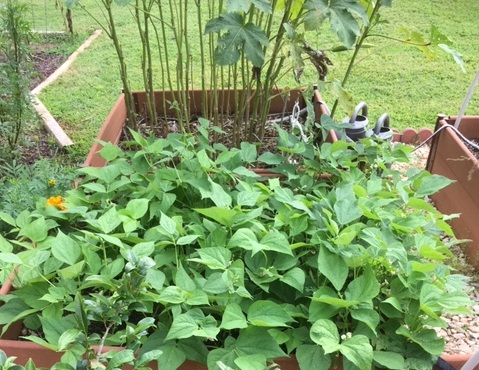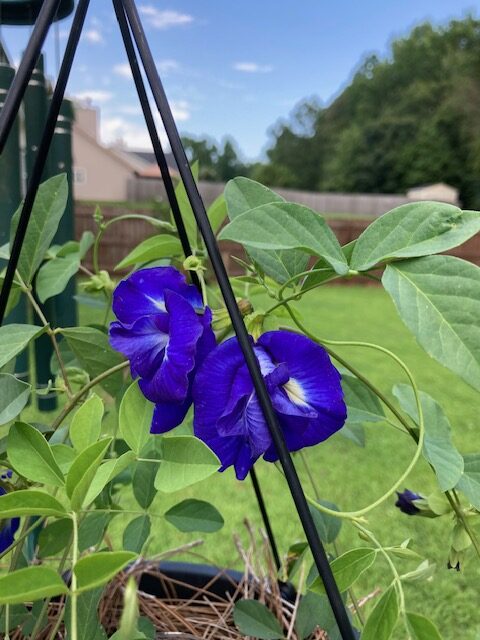
Bean
Like the tomato, beans have both determinate and indeterminate types. Bush beans are determinate, meaning they produce all at once and pole beans will produce–into summer.
|
Bush Beans Blue Lake 274; Contender |
|
Pole Beans Black Night; Cherokee Trail of Tears; Blue Lake Stringless; Kentucky Blue; Kentucky Wonder; Rattlesnake |
|
Fabaceae |
|
Phaseolus vulgaris |
|
Easy |
|
Easy |
|
Annual |
|
4 years if properly stored |
|
6-14 Days, depending on the variety. |
|
None Optional: can add a legume inoculant (follow the packaged instructions) |
|
1 inch |
|
Bush: 18-20” Pole: supports are recommended to be 6-8′ high. |
|
Full Sun |
|
40-73 days depending on the variety |
|
April, May |
|
Yes |

Growing Tips


5 plants per 12” container. Pole varieties will need a trellis. –You might have better success with a 5 gal bucket.
When to Start
Spring: Direct sow after the danger of frost has passed.
Fall: Direct sow 10-12 weeks before the first frost. (for GA Bush–July 5-Aug 10 Pole–July 1-Aug 1)
How to Start
Know if you have bush or pole variety. Bush will typically support itself, but Pole beans require staking or a trellis.
Bush beans are also determinate, producing all at once. For a continual harvest, try succession planting. This is planting every week or every other week. Or for food preservation, plant them at the same time for a large harvest perfect for canning, freezing, or other food preservation methods.
Pole beans are indeterminate and will produce throughout the growing season.
I remember which is which by what my Mom always told me, “Indeterminate will grow into summer.” Meaning they will grow throughout the summer.
Direct sow to a depth of 1 inch deep and into full sun beds with rich, well-draining soil. Beans do not transplant well due to their fragile root system. Plant in hills or rows. If planting Pole beans, place your stakes or trellises at the time of planting. Thin bush beans to 4-6 inches and pole beans to 7-12 inches.
Care
Beans need adequate moisture; water bean plants about once a week or more frequently during dry weather. A good rule of thumb is to keep the soil moist, but not soggy. The use of organic mulches, such as straw, will help to retain moisture and control weeds. Beans are a member of the legume family and as such are nitrogen fixers. They will fix nitrogen in the soil making it available for plants to take up.
Harvest
Harvest in the morning for peak flavor. Pole beans are ready for harvest when the pods firm but the seeds are not fully developed. Be careful to not break the stems. Bush beans are ready when they are about 3-5 inches long. To use as dried beans, allow the pods to dry and turn brown on the plant. Don’t allow them to get wet as this will cause the beans to sprout and mold in the pod.
For drying beans, you wait until the pods are brown and dry before harvesting. It is exactly the same as when saving bean seeds. Pick the beans after the pods are ripe and have dried on the plants. Don’t allow dried pods to get rained on as the beans may quickly mildew or sprout in their pods. When very dry, most pods will split on their own to drop their seeds. The rest can be easily crumbled in the hands and the finer chaff blown away after removing the big pieces. Finish drying the beans in a dry spot indoors or undercover.
Pro Tip!
Incompatibles: Fennel, garlic, all onions
Grows well with: Beets, cabbages, carrots, celery, corn, cucumbers, eggplant, peas, potatoes, radish, and strawberries
My personal experience
I love fresh green beans. I’ll pan-fry them in a little olive oil with salt. As they start to brown, I’ll add a little garlic powder. Then I let them get good and brown. That is the only way I’ll eat green beans. So Good! I start my beans a couple of weeks before all danger of frost has passed (April 15). It’s rare to get a freeze after this. We can here and I’ve been burned (frozen) before and had to replant. I’ve found that at least with the variety I grow, I get the best flavor if I start this early and I have less trouble with pests.
I plant my bush beans closer together than the proper spacing requirements as I’ve found the variety I grow needs the support of their neighbors or they will break. I’ve also had to use a rope to tie around the bed to keep them from spilling over the sides. However, with any pole beans I end up planting, I do follow spacing guidelines. Beans are nitrogen fixers, meaning they are a plant that will fix nitrogen in the soil. Outside of fertilizers, the normal way plants get nitrogen is from thunderstorms. The basics are this: lightening splits the atoms, rain brings the nitrogen down to the soil, and then plants can take it up through the roots.
Rotate the legumes (beans, peas, lima beans, butterfly pea pictured right, etc.) around the garden to help enrich the soil for other plants. You can also plant beans next to heavy feeders like squashes and they will benefit each other.


Seed Saving

Isolation Distance
Members of the Bean Family are self-pollinating and crossing is uncommon, but rare varieties can be separated by 100 feet to ensure purity.
Instructions
Similarly colored varieties should be separated by enough distance to keep the vines from intertwining, to make them easy to distinguish at harvest.
Pick beans for seed after the pods are ripe and have dried on the plants. Don’t allow dried pods to get rained on as the beans may quickly mildew or sprout in their pods. When very dry, most pods will split on their own to drop their seeds. The rest can be easily crumbled in the hands and the finer chaff blown away after removing the big pieces. Finish drying the beans in a dry spot indoors or undercover.
A DANGER with members of the Bean Family is late summer rains, which can moisten seeds drying in their pods while still on the vine. Too much moisture during seed maturation lowers the viability and storage life of the finished seeds, and can even cause them to sprout or mildew while still on the vine.
Features
- Contender Bush: It produces heavily and has round, oval pods. As an early bean, it does well in cool conditions, but also thrives in the heat.
- Blue Lake 247 Bush: Heirloom. Medium-thick pods that are 5-6 inches long.
- Black Night Pole: 65-85 Days. Heirloom. It has scarlet red blooms that yield black beans. It can be used either as snap beans or allowed to dry on the vine for dried beans.
- Blue Lake Stringless Pole: Harvest at about 5.5 inches long. The pods have a mild flavor.
- Cherokee Trail of Tears Pole: Heirloom. Vigorous vines that produce pods good for both snap and dry beans.
- Kentucky Blue Pole: A heavy-yielding beans that have 7-inch long pods. Will produce until frost.
- Kentucky Wonder Pole: Heirloom. Stringless when young.

- Soil temp needs to be at least 65F for seeds to germinate well. Otherwise, seeds may rot.
- If you’re eating your beans green, allow just one or two pods per plant to remain and mature for seed. Too many pods maturing on an individual plant will cause it to stop setting more beans in order for the plant to concentrate on maturing the ones it has.
- Some people are allergic to the oils secreted by the leaves of bean plants. If you develop a rash, there is an way to still grow beans. Wear gloves and arm protection when harvesting. Then wash hands and arms with soapy water after harvesting. For many these precautions will be enough, otherwise seek the advice of a doctor.
